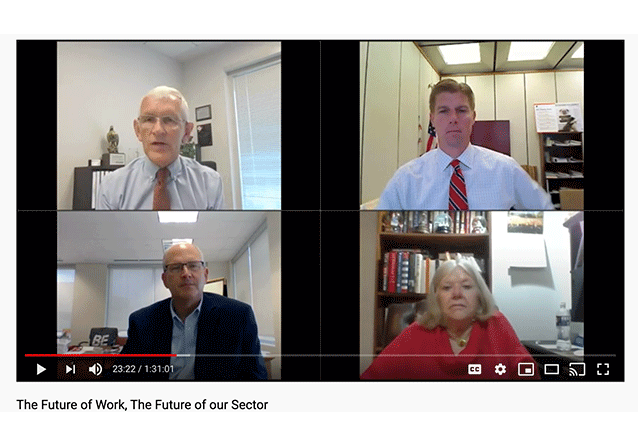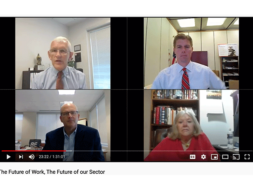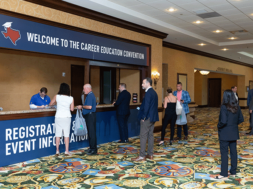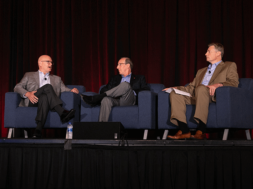
Career Colleges Poised for Growth Despite Pandemic, Economy
Written from the CECU Keynote Session, The Future of Work, The Future of our Sector
An ongoing pandemic and an economic downturn are creating challenges for many industries, but should provide opportunities for career schools that are poised to train new employees with skills needed for post-pandemic jobs.
Career Education Colleges and Universities (CECU) held its first-ever virtual convention in June, and kicked off the program with “The Future of Work, The Future of Our Sector.” More than 1,300 people registered for the virtual convention that featured 50 concurrent sessions and virtual exhibitors.
In the opening session, CECU President and CEO Steve Gunderson and three panelists discussed the challenges and opportunities career colleges face in today’s challenging climate.
Gunderson said some careers are expected to do well post pandemic, including fields like IT infrastructure, software development, inventory and distribution logistics, domestic manufacturing, telemedicine, nursing, public health, marketing and others.
But besides offering programs in fields expected to be in demand, career schools also cater to communities of color, who were hit the hardest by the pandemic, he said.
“There is a new challenge and a new sense of urgency to make sure we are ready and able to serve those adults who come back for skills to pursue a second career,” Gunderson said.
The career college sector has an ability to adapt quickly to changes in the marketplace, which will make the sector stronger, he said. While most schools are moving to an online/onsite blended model of instruction, career schools already know how to deal with retention onsite. So now they just need to take that knowledge to the online platform, which is known to have a higher dropout rate, to ensure they keep those students, too.
While the sector overall has been focused on regulatory issues around financial aid and Pell grants, it must also lobby for things that will broaden their reputation and reach, such as public loan forgiveness, Gunderson said.
“That may be a conversation we need to be involved in for essential workers,” he said. “If we can help that student with his or her debt, we would do everyone a favor.”
Retention, graduation and placement will be more important than ever before, especially for minority students. That means all schools need to do the analysis to determine if a student is able to succeed academically. And if the answer is no, then they need to work with that student to give him or her the skills to succeed at a later time, he said.
With the great likelihood that many schools will be teaching courses online, schools must also work to eliminate the digital divide.
“We need to seriously consider ways to include those digital tools as part of our basic fees,” he said, adding that career schools also need to become huge advocates for targeting Pell grants to low-income students.
Gunderson said CECU’s goals for 2020 include seeking consensus for changes in 90-10, growing bipartisan support for the career college sector, and protecting veteran access to career education.
But most importantly, career colleges must tell their stories to Congress, to the media, to our communities and beyond, he said.
“If you have graduates in the frontline of this pandemic, tell their story,” Gunderson said.
The three panelists agreed there are reasons for the sector to be optimistic.
“The economy was booming prior to the pandemic,” said Scott Stump, the U.S. Department of Education’s assistant secretary for career, technical and adult education, “and I believe that as the economy opens up, (jobs) will come back.”
The question becomes if those employees will want to go back to their old jobs, he said. If not, that will create more opportunities for career schools to offer training in the needed fields.
John Pallasch, assistant secretary for the Department of Labor’s Employment and Training, agreed.
“The fundamental difference is that this 13.3% unemployment rate was due to a choice we made to shut the country down,” he said. “So there aren’t foundational issues that will prevent job growth.”
However, partners will need to work well together. “We need to make sure we are connecting employers with students, with job seekers, so when folks are graduating from any program, that there is an employer ready to hire them,” Pallasch said, noting that local and state public workforce systems need to work to ensure that connection exists.
Jane Oates, president of WorkingNation, a nonprofit campaign founded in 2016 to create and amplify solutions for a changing economy, predicted that public workforce systems will be a big part of this recovery and allow Americans to get back to a new normal.
That doesn’t mean there won’t be challenges. One of the biggest will be how to get exceptional outcomes when face-to-face clinicals are not an option in many states.
“We have to figure out a better way to do this, to get students their clock hours so they can sit for exams,” Oates said. “But we also need to support people and not to have them become discouraged. We need to send a unified message that they didn’t fail…”
Stump said even before the coronavirus, placement had always been the limiting factor in students accumulating hands-on experience. But especially during a pandemic, career colleges need to become more creative in how they can get students back into their simulated environments, or convince their state leaders that perhaps students need fewer hours before they can sit for exams.
Flexibility is going to be key, Pallasch said, and schools will need to be as understanding as they can as telework becomes a reality.
“Digital will be a big factory in the recovery,” Oates said. “Career Schools need to double down on speed and flexibility.” She said schools need to give students bite-size chunks as they work toward their degree, from recognized credentials on up.
“So if you’re looking at a two-year nursing program, stack sources so they could be a EMT or a pharmacy tech on their way to being a nurse,” she said. “We all know that students are working when they’re going to school, so why not have them growing their resumes while building their skills?”
In the past, the career education sector’s image took a hit when it produced too many graduates for a specific job. The best way to stop that from happening again is to work with local businesses first, they said.
“Most students will work 18 miles from where they grow up,” Stump said. Schools need to have advisory councils or sit on workforce boards, if they want the best information about where local job growth will occur.
“The key is looking locally and having conversations with employees,” Stump said, “and not just doing it once, but checking back since this situation is going to evolve.”
Oates said she believes the U.S. will be committed to creating a domestic supply chain in manufacturing, logistics and marketing. “I don’t think we as a country will ever let us be out of toilet paper again,” she said. “This pandemic has exposed weaknesses we knew about for decades. I hope there will be bipartisan commitment to making things here, and the supply chain will be rebuilt.”
The industry also needs to have more industry recognized apprenticeship programs, the panelists agreed, because the model works. Career schools must understand what sectors it can grow in, and then help employers build a pathway to that, they said.
In the next six months, all schools will have learners experience barriers they haven’t dealt with before, Stump said. Institutions need to be good listeners, show empathy, identify barriers and reach out to workforce centers on how best to address those barriers.
In addition, students — and particularly their parents — need to understand that a four-year bachelor’s degree is not the right path for everyone.
“For some parents, it’s because they want better for their child,” Oates said. “But I think you have to admit and have open conversations about the predatory players who were in this space and are now gone.”
Many parents, particularly parents of color, still question the success of career colleges since they may know victims who were taught skills at a high price that didn’t allow them to find gainful employment.
“You need to explain how the landscape is different now than it was before, and lead with the outcomes,” she said.
Pallasch agreed, and said only the outcomes will change people’s opinions and perspectives. “You need to challenge the stigma by pointing to the tangible outputs, simply the graduates with jobs in their fields,” he said.
Stump said the DOE is launching a national campaign to push people to rethink the multiple pathways that exist to enter the workplace.
“Since 1983, we’ve driven toward one target — a four-year degree for all students,” he said. “Yes, that might be a worthy undertaking. But our economy needs a width and breadth of trained individuals that we’ve missed for the last 20 years, and this campaign is meant to challenge that type of thinking.”
Stump said students need to make informed decisions about where to go to school, if there are to be successful outcomes. “As a department, we are trying to move away from education-based hiring and move toward skill-based hiring.”
Pallasch said everything needs to have a next step. “Work with the workforce system to lay out pathways because students shouldn’t have to find those on their own,” he said.
He said there is a lot of money available now for job training through the CARES Act. “The wheel has been idle for three months … so states need to be ready and engaged,” he said, and get students to train for a better job and then a lifelong career.
Improving retention in distance education must also be a priority.
First, you need to make sure students are in the right program, Stump said. As of July 1, 2019, only about one in three high school students had work experience, and today that number is even less, he said.
“If a student has never been in a workplace, how do they know what they want to do?” he asked. “If they don’t have experience in healthcare, schools need to give them an experiential course at the front end…”
Instructors also need professional development, so they rethink the instructional process, Stump said.
Unfortunately, there are thousands of students who had horrible experiences this spring with online learning as schools closed due to the increasing numbers of positive COVID-19 cases.
“I worry for your members who have no experience in online teaching; they must put in time and money for training … and make sure they have a really good platform,” Oates said. They also need to figure out a way to engage students, whether it’s sending a text when a student misses a class, or calling out someone for doing something terrific.
“That type of encouragement is more important in an online environment,” she said.
As for final advice? The three had different messages to tell the career college leaders.
“Believe in government,” Oates said. “It’s easy to despair that the government isn’t working. But 99% of the people (working in government) are policy people and really care about the outcomes.”
Stump encouraged the leaders to know their sector and remember that they are training many of the front-line workers who are currently taking care of people in America today.
“Keep up that work, and figure out that new reality,” he said. “Yes, the world has changed. But you as institutional leaders have to create a new experience and make it learner-centric. Figure out a way to get that learner across the finish line.”
“And if you’re not involved, get involved,” Pallasch said. “And if you are involved, get more involved. The more we can be talking across sectors and partners … the better the results will be. We need to all pull in the same direction. Don’t think of yourself as a silent partner. Get to know those partners, and ask for help when needed.”



